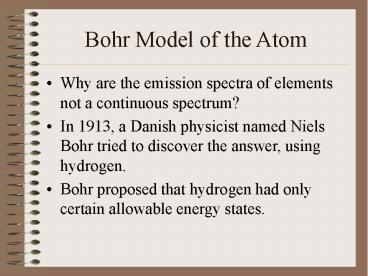Bohr Model of the Atom - PowerPoint PPT Presentation
Title:
Bohr Model of the Atom
Description:
Bohr Model of the Atom Why are the emission spectra of elements not a continuous spectrum? In 1913, a Danish physicist named Niels Bohr tried to discover the answer ... – PowerPoint PPT presentation
Number of Views:462
Avg rating:3.0/5.0
Title: Bohr Model of the Atom
1
Bohr Model of the Atom
- Why are the emission spectra of elements not a
continuous spectrum? - In 1913, a Danish physicist named Niels Bohr
tried to discover the answer, using hydrogen. - Bohr proposed that hydrogen had only certain
allowable energy states.
2
Hydrogens Energy States
- The lowest energy state of an atom ground state.
- When the atom gains energy excited state.
- Bohr said hydrogen, even with only 1 e-, is
capable of many different excited states and
these are related to the orbit of the e- in the H
atom.
3
Hydrogens Energy States
- Bohr said that the single e- of hydrogen orbited
the nucleus in only certain allowed circular
orbits. - The smaller the orbit, the lower the energy state
(energy level) the larger the orbit, the higher
the energy state (energy level) - Bohr assigned a quantum number, n to each orbit.
The one closest to the nucleus he numbered 1,
the next 2, etc.
4
An explanation of Hydrogens energy states
- In the ground state, (n 1) the atom does NOT
emit energy. Normal state. - But when excited, the e- jumps up to a higher
energy level (n 2, or 3) - When this excited e- drops back to the ground
state, it emits a photon equal to the difference
in energy between the 2 energy levels.
5
Explanation, continued
- Because only certain orbits are possible, only
certain frequencies of EM radiation can be
emitted. - Think of the energy levels as rungs on a ladder
you can only go up or down on the rungs, NOT
in-between.
6
ORIGIN OF THE LINES IN THE HYDROGEN EMISSION
SPECTRUM
7
The problem with Bohr
- Bohr explained hydrogens spectral lines almost
perfectly. - However, it did not explain any other element!
- It also did not explain other chemical behavior.
- And though his work was groundbreaking, later
experiments proved his model fundamentally wrong.
Electrons dont move around the nucleus in
circular orbits. - Alas, poor Bohr!
8
Enter Louis de Broglie
- In the 1920s, French graduate student Louis
deBroglie asked, if waves (light) can behave
like particles, can particles (electrons) behave
like waves?
9
The de Broglie Equation
- deBroglie eventually derived an equation to
explain the wave properties of particles. - ? _h_
- mv
- ? wavelength of particle
- h Plancks constant
- mmass of particle
- v velocity
10
The de Broglie Equation
- This equation proves that all moving particles
have a particular wave property - Why cant these waves be seen, like light?
- They simply are too small. Even sensitive
instruments cant detect these waves. - When large objects move, when their large mass is
divided into the small number of Plancks
constant, the resulting wavelength is very, very
tiny. - Electrons, on the other hand, have almost NO
mass, so their wavelength is easily measured.
11
Heisenberg Uncertainty Principle
- The de Broglie equation ultimately was proven
correct. - The next scientist to contribute to our
understanding of the atom was German physicist
Werner Heisenberg. - Heisenberg said that its impossible to make a
measurement on an object without disturbing it
at least a little bit.
12
Heisenberg Uncertainty Principle
- The smaller the object, the more it is disturbed
by measurement. - For an electron, even shining light on it will
disturb its frequency and position. - Therefore, Heisenberg concluded, it is
impossible to know precisely both the velocity
and position of a particle at the same time. - Scientists of the time found it hard to accept,
but later tests proved it true. - It shows that the uncertainty of any electrons
position is VERY large.
13
(No Transcript)
14
(No Transcript)
15
Schrodingers Wave Equation
- In 1926, Austrian scientist Erwin Schrodinger
further refined de Broglies equation. - He developed a very complex equation that treated
the hydrogen electron as a wave. It worked
perfectly for not only hydrogen, but ALL
elements. - It is the basis for the current model for
electrons in atoms, the quantum mechanical model.
16
Basics of Quantum Mechanics
- The Schrodinger equation defines the basis of
energy levels and possible locations of electrons
in atoms. - An electrons location is simply a probability of
where it can be located at a given time. - To make probability predictions easier, quantum
mechanics assigns numbers to energy levels and
shapes to sublevels.
17
(No Transcript)
18
Basics of Quantum Mechanics
- Principal Quantum number (n) relative size
energy of the atomic orbitals (where an electron
can orbit the nucleus) - As n increases, the orbital gets larger, the e-
spend more time away from the nucleus, the
energy level increases. - Therefore, the Principal Quantum number
represents Principal Energy Levels. - The lowest energy level is assigned the number 1.
Up to 7 levels are possible for hydrogen.
19
Energy Levels
20
Sublevels
- Principal Energy levels contain sublevels (also
called orbitals). - Energy level 1 has 1 sublevel, level 2 has 2
sublevels, 3 has 3 and so on. - The sublevels are named for their shapes, as
follows sspherical pdumbbell d varying
shapes (mostly lobes) and f varying shapes
(like flower petals, almost) - Each orbital can hold up to TWO electrons,
maxium.
21
(No Transcript)































